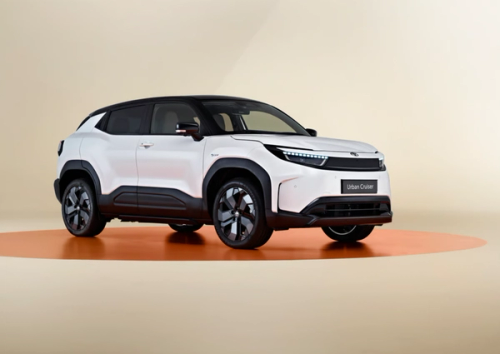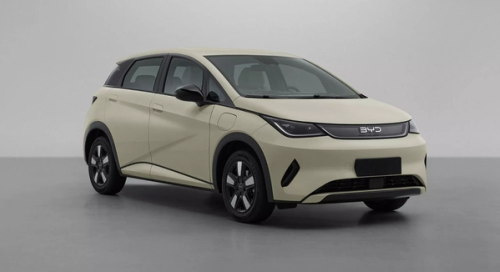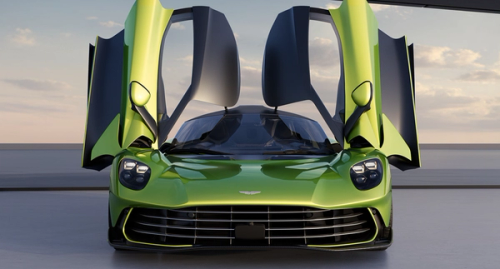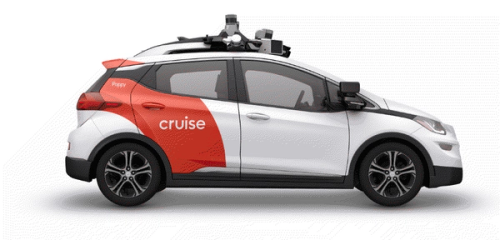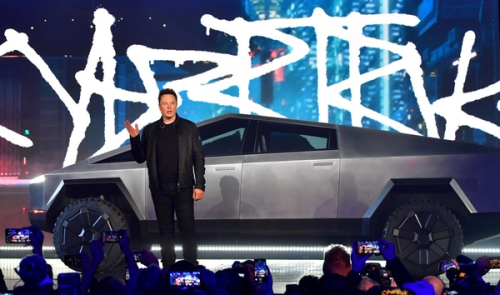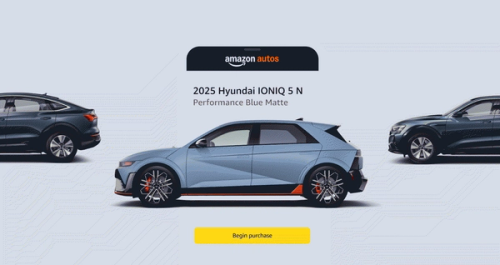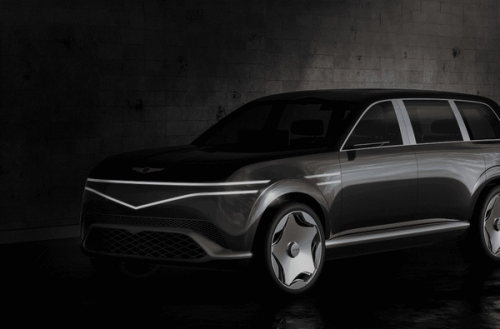Elon Musk reveals as fully autonomous robotaxi
13 Oct 2024
28
By Shashwat

Robotaxi
Tesla Cybercab revealed as fully autonomous robotaxi

The Tesla Cybercab is a futuristic autonomous vehicle concept from Tesla, which Elon Musk has confirmed will enter production before 2027. This innovative vehicle represents a significant departure from traditional car designs, as it will not have a steering wheel or pedals. The absence of these controls implies that it will be a fully autonomous vehicle, meaning production can only commence once all necessary regulatory approvals are secured for its self-driving capabilities.
Like other Tesla models, the Cybercab will feature a minimalist interior, with seating for two passengers and a large, centrally mounted touchscreen that will control most of the vehicle's functions. This design approach is similar to what is seen in Tesla’s current lineup, particularly the Model 3 and Model Y, where physical buttons and knobs are replaced with digital controls managed via the display.
The Cybercab's exterior design is reminiscent of Tesla’s other models, especially the Cybertruck. It will have a full-width LED light bar on the front, giving it a modern and futuristic look. The vehicle will also share some design elements with the Model Y, including distinct creases and wide rear shoulders. One of its standout features will be its unique butterfly doors, which mark a first for Tesla vehicles. These doors add to the Cybercab’s striking appearance and futuristic design language. Additionally, the vehicle will come with full wheel covers, a feature that Tesla claims will help increase the range of the vehicle by improving aerodynamics.
Another notable design choice is that the Cybercab, like the Cybertruck, will not have a rear window. Despite this, the vehicle will offer a large boot at the rear for storage, making it practical for transportation needs. However, Tesla has not yet provided any details about the Cybercab’s powertrain or other specifications, leaving much of its technical performance still shrouded in mystery.

Tesla’s ambitious plans for the Cybercab align with its broader vision for autonomous driving and futuristic vehicle designs, but as of now, the company is still awaiting regulatory clearance for full self-driving technology. This requirement is a key factor that could influence the timeline for the Cybercab’s production.
In terms of market expansion, Tesla has previously expressed interest in entering the Indian automotive market, though progress on this front has been slow. The company has faced challenges related to regulatory policies and infrastructure in India, which has delayed its entry into the region. While Tesla continues to expand its presence in other global markets, it remains uncertain when or if the Cybercab will be available in India.
Overall, the Tesla Cybercab represents a bold step forward in autonomous vehicle development, with its groundbreaking design and technology setting it apart from traditional vehicles. However, many details about the Cybercab, including its powertrain and exact capabilities, remain undisclosed, making it a highly anticipated yet enigmatic project in Tesla’s future lineup.
Elon Musk faces $40 billion loss after launching of cybertaxi

Elon Musk’s introduction of Tesla’s new Robotaxi, a fully autonomous two-seat vehicle without a steering wheel or pedals, was met with significant disappointment by Wall Street. Tesla's stock dropped by around 8.8% during Friday's premarket session, leading to a staggering $40 billion loss in the company’s valuation, as reported by the *Wall Street Journal*. Despite the event being anticipated as a major step for Tesla, many investors and analysts felt that the presentation lacked the concrete details and timelines they were expecting.
The Robotaxi Announcement
The Robotaxi is described by Musk as Tesla's most important product launch since the Model 3, which debuted in 2017. It embodies Tesla’s vision of a fully autonomous future, where vehicles will no longer require human input, steering wheels, or pedals. With the Robotaxi, Musk envisions a world where autonomous cars reduce traffic congestion, eliminate the need for parking lots, and transform the way people move in urban areas.
However, the announcement seemed to focus more on Tesla’s long-term vision than on delivering specific details that investors were hoping for. According to Tom Narayan, an analyst at the Royal Bank of Canada, many investors were left underwhelmed because the event appeared to be more about marketing Tesla's future ambitions rather than providing hard numbers, production specifics, or definitive timelines. While Musk briefly mentioned that the Robotaxi would enter production in 2026 and would be priced below $30,000, the lack of substantial details created unease among investors, especially considering the scale of the technological advancements required to make the vehicle a reality.
Wall Street's Reaction and Market Valuation
Tesla's stock had surged in anticipation of the event, reflecting high investor expectations about the new product. Before the announcement, Tesla’s market value was approaching three times that of Toyota, the world’s largest carmaker by sales. However, the excitement quickly evaporated after the event. The market's negative reaction stemmed from the lack of clear guidance on production, cost, and timelines for the Robotaxi, which investors typically expect at Tesla's high-profile announcements.
The 8.8% drop in Tesla’s stock price wiped out $40 billion from its market capitalization. This sharp decline highlights how crucial it is for Tesla to maintain investor confidence, particularly as the company is valued at a much higher level than many traditional automakers. Tesla's ambitious goals, like fully autonomous vehicles, are a key reason for its sky-high valuation, but these goals also carry substantial risks.
The Challenges of Full Autonomy

The technological leap to full autonomy is a major sticking point for many industry analysts. Jessica Caldwell, head of insights at Edmunds, expressed skepticism about Tesla's ambitious timeline for the Robotaxi. She noted that achieving fully autonomous driving, especially with unsupervised vehicles that lack steering wheels or pedals, will require immense technological breakthroughs. Caldwell's comments reflect the broader sentiment that, while Tesla has made significant progress in electric vehicles and semi-autonomous driving technology, full autonomy is still a distant reality for the automotive industry.
Autonomous driving technology involves overcoming complex challenges, particularly in creating systems that can handle the unpredictable nature of real-world driving without human intervention. While Tesla has made strides in its self-driving technology, there have been numerous delays and challenges along the way. Regulators in many countries are also cautious about approving fully autonomous vehicles, as safety concerns remain a priority. These regulatory hurdles could further complicate Tesla's goal of having the Robotaxi in production by 2026.
Tesla's Vision vs. Reality
Musk's vision for Tesla has always been bold, pushing the boundaries of automotive technology. He presented the Robotaxi as a game-changer for cities, with autonomous vehicles reducing traffic, minimizing the need for parking lots, and revolutionizing transportation. However, Tesla's road to full autonomy has not been without obstacles. The company has faced criticism over the development and safety of its self-driving features, including ongoing scrutiny from regulatory bodies regarding the safety of its Autopilot and Full-Self Driving (FSD) systems.
The leap from Tesla’s current semi-autonomous technology to full autonomy will require not only significant advancements in artificial intelligence, sensor technology, and vehicle control systems, but also a regulatory framework that supports such vehicles. These challenges mean that Tesla's timeline for the Robotaxi could be overly optimistic. Even if Tesla is able to develop the technology within its projected timeframe, securing the necessary regulatory approvals and building public trust in fully autonomous vehicles without any manual controls will be a lengthy process.
Investor Expectations and the Future of Tesla
Investors are growing increasingly wary of Tesla’s ambitious promises. While the company has revolutionized the electric vehicle market and made considerable progress toward autonomous driving, many feel that the timeline for full autonomy is unrealistic. The Robotaxi, while representing the future of transportation in Tesla’s eyes, may not meet investor expectations if Tesla cannot provide more concrete evidence of its feasibility in the near term.
Tesla's ability to maintain its high market valuation hinges on its continued innovation and execution of its bold ideas. The drop in Tesla's stock following the Robotaxi announcement reflects a broader concern about whether Tesla can deliver on its ambitious goals within the promised timeframes. Tesla has made a habit of defying expectations and pushing the automotive industry toward new frontiers, but as the company enters the realm of fully autonomous vehicles, it faces new challenges that go beyond manufacturing and into the realm of artificial intelligence and regulatory hurdles.
Conclusion
The introduction of Tesla's Robotaxi is a bold step toward the future of transportation, but it comes with significant risks and challenges. The lack of specific details about the Robotaxi's production timeline, cost, and technological capabilities left investors uncertain, leading to a sharp drop in Tesla’s stock value. While Musk’s vision of a fully autonomous future is inspiring, the technological and regulatory barriers to achieving that vision within the projected timeline are significant.
Tesla's success has often been driven by its ability to innovate and push boundaries, but full autonomy is a complex and ambitious goal. The next few years will be crucial for Tesla as it works to turn the Robotaxi from a futuristic concept into a commercial reality. Investors will be watching closely to see if Tesla can deliver on its promises and maintain its leadership in the fast-evolving automotive industry.

